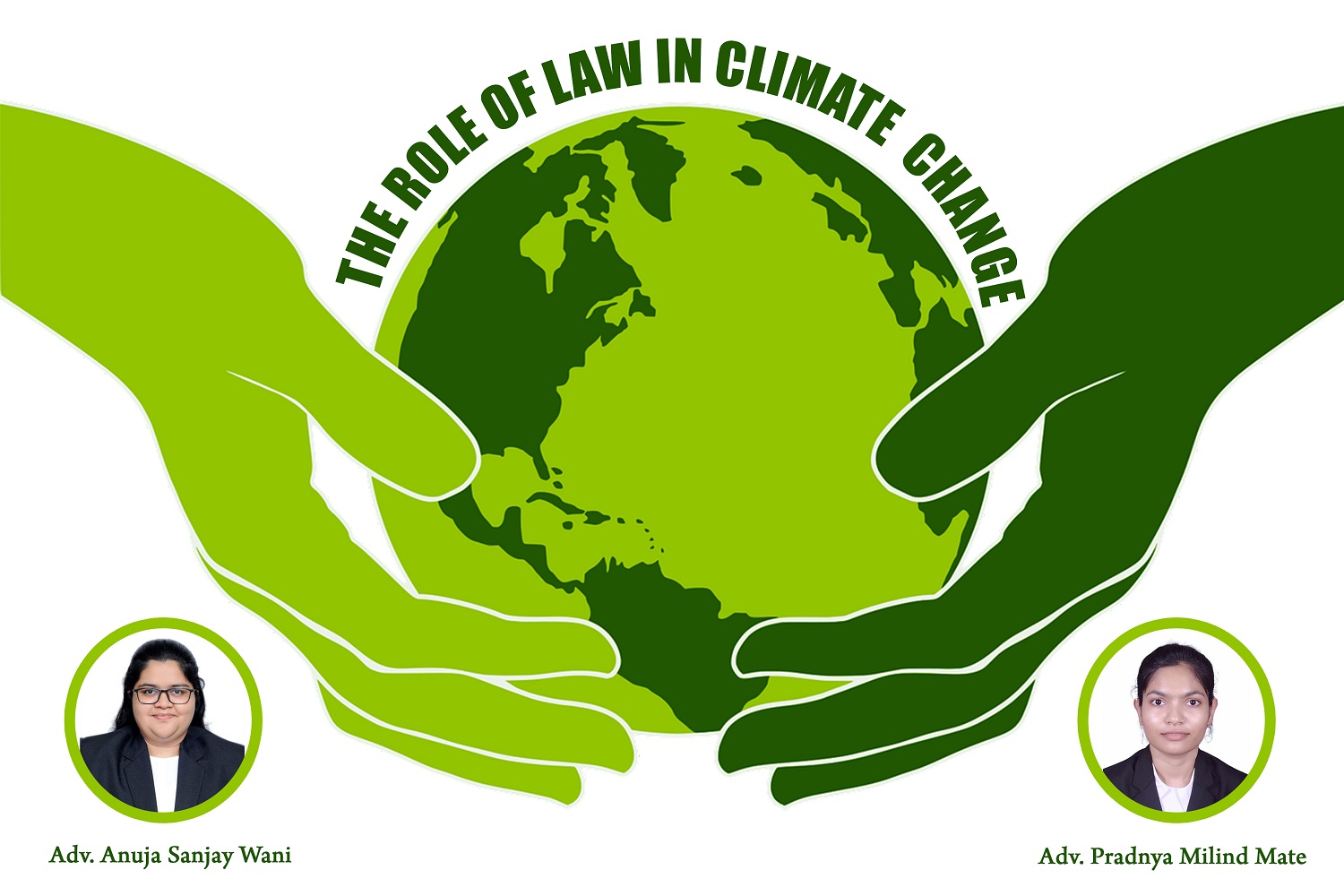The Role of Law in Climate Change by Adv. Anuja Sanjay Wani and Adv. Pradnya Milind Mate

Abstract:-
These roles belonging law in climate change encompasses a complex interplay of legislation, international treaties, and judicial actions that shape the global response to environmental issues. This essay will discuss the legal frameworks established to combat climate change, explore the influence of prominent legal figures, analyze various perspectives on climate law, and consider potential future developments in this critical area.
The thing created a structure to global organization into global environmental shift as well as acknowledged those need in order to substantial Decrease in carbon emissions. The subsequent Kyoto Protocol of 1997 introduced binding targets for developed countries, signifying a shift towards enforceable obligations. The 2015 Paris Agreement built upon these foundations, targeting a global temperature increase of no more than 2°C above pre-industrial levels.
KEY WORDS: Weather, Air Pollution, Water Pollution, Forest
Introduction:-
Lately, the influence of law in addressing climate emergency has been amplified by the role of national courts. Landmark legal decisions have ignited public discourse and influenced policy. For instance, the Dutch Supreme Court ruled in 2019 that the government need to take more ambitious steps in cutting emissions, thereby reinforcing the notion that citizens have a right to a safe climate. Similar legal cases in various jurisdictions, including the case brought by teenagers in the United States and the Uganda case in the Netherlands, demonstrate a growing trend of leveraging the legal system to demand accountability from governments and corporations.
Key individuals have been instrumental in shaping climate law and policy. Greta Thunberg, a young climate activist, has become a symbol of the youth climate movement. Her advocacy highlights the urgent need for legal frameworks that respond to the climate crisis. Legal experts, former President of Ireland, have emphasized the importance of integrating human rights perspectives into climate legislation, arguing that climate change disproportionately affects vulnerable populations. The convergence of these voices underscores the multidimensional nature of climate law, encompassing environmental, social, and economic aspects.
Various perspectives emerge in the discourse surrounding climate law. Some argue that the legal frameworks established are inadequate in addressing the scale of the crisis. Critics highlight the shortcomings of voluntary commitments in the Paris Agreement, emphasizing the need for binding international regulations. Others advocate for national sovereignty, suggesting that countries should have the autonomy to determine their approaches without external constraints.
This debate raises questions about the effectiveness and fairness of climate governance.
History:-
In the beginning, the environment did not deteriorate much, so there was no pollution, bad water, adulterated food. Slowly over time everything changed and people started incorporating modern things. There was more room for pollution in factories and other places so people’s lives were not affected much. Earlier the living conditions of the people were orderly and because they were kept simple and neat, the effect was on the climate. Life was easy because everything was pure. As earlier sugar mills were very small, people had very few vehicles, petrol was not used so smoke could not escape from the engine and spread into the air. Earlier people used to breathe clean air, thus improving their health.
Meaning:-
The role of law in combating climate change in urban areas in India has emerged as a critical concern. This article will discuss the legislative framework, the effects of legislation on urban conservation, influential figures within the environmental law space, and future challenges and opportunities. The analysis will provide an understanding of how the legal system can help address climate change effectively.
Urban Areas:-
In urban areas people become busy with work and their life runs like clockwork. They have changed their outlook on life. As agriculture and climate are not much in the city, there is a lot of trouble there. Adulteration in water, adulteration in wind have become common. People are used to those things. So they can relate to that climate. But it spreads different diseases. And it can cause fatal harm. 40% of people suffer from various diseases due to climate replacement. It has become necessary to reduce that quantity.
Rural Areas:-
Many people in rural areas eat this nutritious and simple meal. The atmosphere there was pure and serene. Agriculture and weather are more common there so the weather there is nice and natural. As there is not much transmission of diseases, people do not need a lot of doctors and medicines. And it cause fatal harm. 10% of people suffer from less various diseases due to climate replacement.
Air Pollution:-
Air pollution is a very crucial issue. We need air to breathe and if it is not clean, we suffer. And he also increases diseases. As different chemicals spread in the air and enter the body through the respiratory tract, the organs become brittle. And it affects the body and organs.
Water Pollution:-
Various diseases also occur from water. Climate change has happened so it affects water. Water is a daily necessity of life. 75% of the earth is covered by water. Water is a necessity. Water is an important part of life. Nowadays, people contaminate the water by putting chemicals in it. It affects people’s body. All this is due to climate change.
Forest:-
Forest is also a part of life itself. Looking at the current condition, a forest has caught fire in Los Angeles. The fire has spread to almost 10k acres. It has affected the human life and livelihood there. Due to lack of rain, such terrible accidents can happen. Humans are responsible for changing the environment.
Legislative Framework:-
India’s approach to climate change in urban settings is governed by a constitutionally mandated framework that emphasizes environmental protection. The Constitution of India recognizes the freedom to a clean environment as enshrined in prescribe article, which obligate the state to protect the environment and the duty of citizens to uphold this responsibility. This constitutional basis has led to the formulation of several laws and regulations aimed at managing urban environmental issues. [1][2]
In prescribe act Acts as the foundation of environmental legislation in the country. [3]This the Act enables the central government to adopt measures aimed at preserving and improving the environment. It provides a framework regarding various rules along with regulations focusing on air and water quality management, hazardous waste management, and noise regulation, crucial for urban areas experiencing rapid industrialization and population growth. The Supreme Court in M K Ranjitsinh & Ors. v. Union of India & Ors. ruled that that people have a right to be free from the adverse effects of climate change which should be recognized by the prescribe article of the Constitution.[4][5]6
Moreover, one National Environmental Policy from 2006 highlights the government’s commitment to sustainable development. 5It emphasizes integrating environmental concerns into urban planning and development. Additionally, the Nation Climate Mitigation Plan established in 2008, including the National Mission for Sustainable Habitat, which focuses on increasing energy efficiency within urban environments and supporting eco-friendly urban growth.
Impact of Laws And Policies:-
The laws and policies in place have significantly influenced urban climate action. For instance, cities like Delhi have implemented stringent regulations to curb air pollution, including the Graded Response Action Plan. Under prescribe article of the Indian Constitution is contravention of fundamental freedoms of the Citizens[6]. The citizens of India also has to follow the law related the climate change. Under prescribe article [7]of the Indian Constitution, which allows for the creation of laws to give effect to international treaties, the prescribe Act was enacted.
Furthermore, the introduction of renewable energy policies and incentives has encouraged urban areas to shift towards sustainable energy sources. The state governments have developed policies to promote solar energy, which is essential for reducing greenhouse gas emissions.
The judicial system has also plays fundamental role in imposing environmental laws. Landmark judgments, such as the M. C. Mehta case concerning air pollution in Delhi, have laid legal precedence for enforcement of environmental standards. The Supreme Court has mandated the use of green technologies and has imposed fines on industries violating environmental norms. Legal action against polluting entities has raised public awareness and has led to increased compliance with environmental regulations.
Influential Individual:-
Justice M. C. Mehta is a prominent environmental lawyer recognized for his advocacy in public interest litigation to safeguard environmental rights. His legal battles have set crucial precedents in the environmental justice movement in India.
Additionally, individuals like Dr. Vandana Shiva have been instrumental in advocating for sustainable cultivation and habitat enhancement, emphasizing this vital nature a ecological balance in urban settings. Similarly, numerous climate activists and NGOs have mobilized grassroots movements that promote legal accountability for climate change.
Perspective And Analysis:-
Different perspectives highlight the necessity of a multi-faceted approach to addressing climate change in urban India. The challenge lies in implementing laws effectively while fostering industrial growth and urban development. Critics argue that existing laws are often poorly enforced due to bureaucratic inertia and lack of political will.
On the other hand, civil society organizations advocate for stricter regulations and better enforcement mechanisms. They emphasize the need for citizen engagement in climate action, highlighting the importance of awareness and education in promoting sustainable practices. There is an urgent need to incorporate local communities in decision-making processes to ensure laws reflect the realities of urban life and climate vulnerabilities.
Future Development:-
As India continues to urbanize rapidly, future legal frameworks must evolve to address emerging challenges related to emergency of weather. Adaptation strategies, such as urban planning that incorporates climate-resilient infrastructure, will be crucial in mitigating climate-related risks. The incorporation of climate justice into legal frameworks will also be essential to address the disproportionate burden faced by marginalized communities. Smart city initiatives, which utilize technology to improve urban services, can be leveraged to manage energy consumption and reduce carbon footprint. The nation has develop the laws and reform the laws as according to the nature of the weather. The laws and the regulation is to be followed by the citizens but in India rural people cant follow the law and regulations of the climate change.
Conclusion:-
In conclusion, these part played by law in during addressing environment change in urban areas in India is multifaceted and evolving. The existing legislative framework provides a foundation for climate action, but effective enforcement and public involvement remain challenges. As India grapples with climate change, future legal developments must focus on sustainability, inclusivity, and innovation to ensure resilient urban environments. The impact of climate changes the lives of the people. The citizens of India have to understand the law of weather change. The people of the India has to follow the law of climate change and reform the law under it.
References
Bodansky, D. (2016). The Art and Craft of International Environmental Law. Harvard University Press.
Robinson, M. (2021). Climate Justice: Hope, Resilience and the Fight for a Sustainable Future.
Ebury Press.
UNFCCC. (2015). Paris Agreement. United Nations Framework Convention on Climate Change. Available at: https://unfccc.int/sites/default/files/english_paris_agreement.pdf Vattenfall v. Federal Republic of Germany. (2019). The German Federal Administrative Court ruled on climate protection. Environmental Law Reporter, 49(8), 11008.
Urgenda Foundation v. The State of the Netherlands. (2019). The Hague District Court. Available at: https://www.urgenda.nl/en/themas/climate-case


ADV. ANUJA SANJAY WANI
ADV. PRADNYA MILIND MATE
LL.M, SEM-II Roll No. 02, 2024-2025
LL.M I, SEM –II Roll No. 23, 2024-2025






Excellent analysis! I’ve been experimenting with AI Hug for healthcare communication! AI Hug transforms clinical staff photos into warm introductions that reduce patient anxiety immediately. The approachable feeling AI Hug creates helps establish trust effectively!